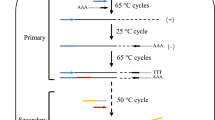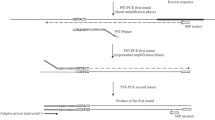Abstract
A genome walking strategy based on annealing and ligation of single-stranded DNA primers to 3′ overhangs following restriction endonuclease digestion was developed. A set of primers contains 4 nucleotides at the 3′ end that are complementary to overhangs formed by restriction endonucleasesApaI;PstI;SacI andSphI. Following ligation, 5′ end overhangs are formed on the DNA, which serves as sites for the adaptor primers and nested primers for PCR amplification in combination with the gene-specific primers. This strategy was verified by the amplification of up to 4 kb of a potato leafroll virus full-length infectious clone. The procedure could be adopted to target any upstream and downstream regions flanking known sequences within the plant genome.
Similar content being viewed by others
Abbreviations
- AP:
-
adaptor primer
- GSP:
-
gene specific primer
- NP:
-
nested primer
- OHP:
-
overhanging primer
References
Anonymous (2006) New England Biolabs catalogue and technical reference. http://www.neb.com/nebecomm/tech_reference/restriction_enzymes/frequency_of_restriction_sites.asp
Arnold C and Hodgson IJ (1991) Vectorette PCR: a novel approach to genomic walking. PCR Methods and Applications 1:39–42.
Ashoub A (2003) Full-length Sequence of Egyptian Potato Leafroll Virus (PLRV) Isolate. Arab J Biotech 6: 173–182.
Lundberg KS, Shoemaker DD, Short JM, Sorge JA, Adams MWW, and Mathur E (1991) High fidelity amplification with a thermostable DNA polymerase isolated fromPyrococcus furiosus. Gene 108: 1–6.
Ochman H, Gerber AS, and Hartl DL (1988) Genetic applications of an inverse polymerase chain reaction. Genetics 120: 621–623.
Riley J, Butler R, Ogilvie D, Finniear R, Jenner D, Powell S, Anand R, Smith JC, and Markham AF (1990) A novel, rapid method for the isolation of terminal sequences from yeast artificial chromosome (YAC) clones. Nucleic Acids Res 18: 2887–2890.
Rishi AS, Nelson ND, and Goyal A (2004) Genome walking of large fragments: an improved method. J Biotech 111: 9–15.
Töpfer R, Matzeit V, Gronenborn B, Schell J, and Steinbiss HH (1987) A set of plant expression vectors for transcriptional and translational fusions. Nucleic Acids Res 15: 5890.
Triglia T, Peterson MG, and Kemp D J (1988) A procedure forin vitro amplification of DNA segments that lie outside the boundaries of known sequences. Nucleic Acids Res 16: 8186.
Upcroft P and Healey A (1993) PCR priming from restriction endonuclease site 3′ extension. Nucleic Acids Res 21: 4854.
Author information
Authors and Affiliations
Corresponding author
Rights and permissions
About this article
Cite this article
Ashoub, A., Abdalla, K.S. A primer-based approach to genome walking. Plant Mol Biol Rep 24, 237–243 (2006). https://doi.org/10.1007/BF02914062
Issue Date:
DOI: https://doi.org/10.1007/BF02914062




